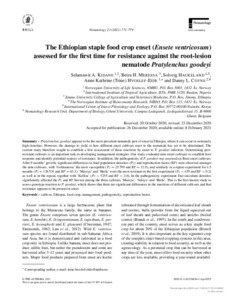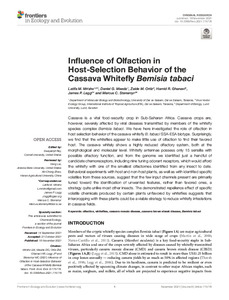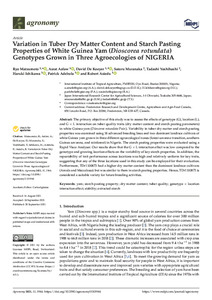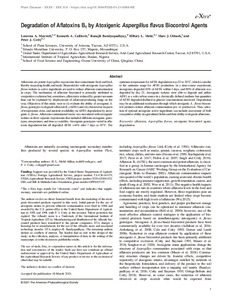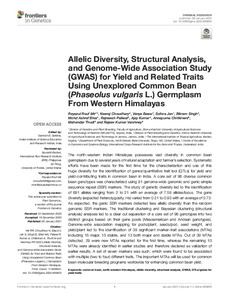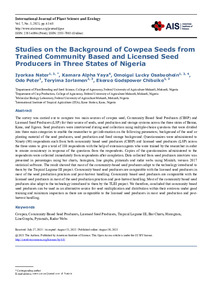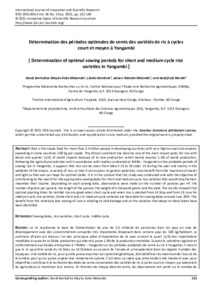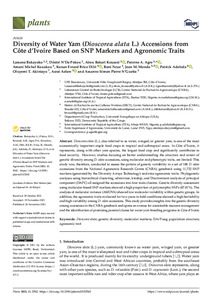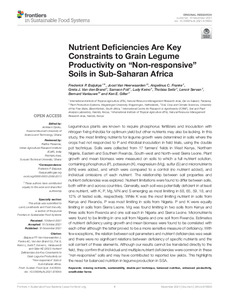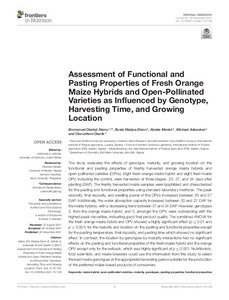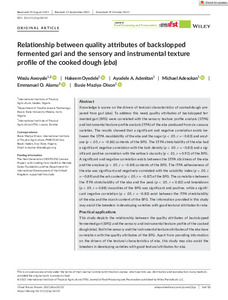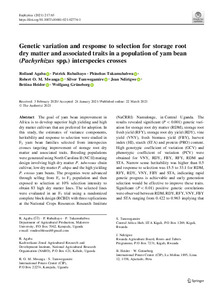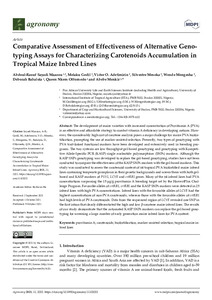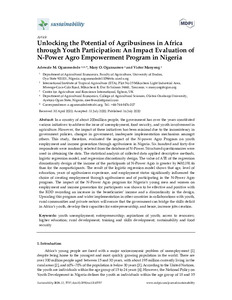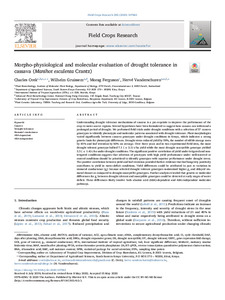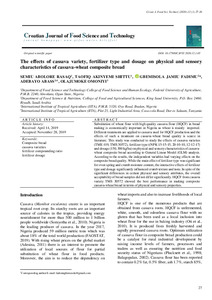Welcome to the International Institute of Tropical Agriculture Research Repository
IITA Bibliography System: Recent submissions
Now showing items 1161-1180 of 7933
-
The Ethiopian staple food crop enset (Ensete ventricosum) assessed for the first time for resistance against the root-lesion nematode Pratylenchus goodeyi
(2021)Pratylenchus goodeyi appears to be the most prevalent nematode pest of enset in Ethiopia, where it can occur in extremely high densities. However, the damage to yield or how different enset cultivars react to the nematode has yet to be determined. The current study therefore sought to establish a first assessment of these reactions by enset to P. goodeyi infection. Determining pest-resistant cultivars is an important task in developing management strategies. Our study evaluated nine enset cultivars ... -
Influence of olfaction in host-selection behavior of the cassava whitefly Bemisia tabaci
(2021-11)Cassava is a vital food-security crop in Sub-Saharan Africa. Cassava crops are, however, severely affected by viral diseases transmitted by members of the whitefly species complex Bemisia tabaci. We have here investigated the role of olfaction in host selection behavior of the cassava whitefly B. tabaci SSA-ESA biotype. Surprisingly, we find that the whiteflies appear to make little use of olfaction to find their favored host. The cassava whitely shows a highly reduced olfactory system, both at ... -
Variation in tuber dry matter content and starch pasting properties of white Guinea yam (Dioscorea rotundata) genotypes grown in three groecologies of Nigeria
(2021)The primary objective of this study was to assess the effects of genotype (G), location (L), and G × L interaction on tuber quality traits (dry matter content and starch pasting parameters) in white Guinea yam (Dioscorea rotundata Poir.). Variability in tuber dry matter and starch pasting properties was examined using 18 advanced breeding lines and two dominant landrace cultivars of white Guinea yam grown in three different agroecological zones (forest‒savanna transition, southern Guinea savanna, ... -
Degradation of aflatoxins B1 by atoxigenic Aspergillus flavus biocontrol agents
(2021-09)Aflatoxins are potent Aspergillus mycotoxins that contaminate food and feed, thereby impacting health and trade. Biopesticides with atoxigenic Aspergillus flavus isolates as active ingredients are used to reduce aflatoxin contamination in crops. The mechanism of aflatoxin biocontrol is primarily attributed to competitive exclusion but, sometimes, aflatoxin is reduced by greater amounts than can be explained by displacement of aflatoxin-producing fungi on the crop. Objectives of this study were to ... -
Allelic diversity, structural analysis, and genome-wide association study (GWAS) for yield and related traits using unexplored common bean (Phaseolus vulgaris L.) Germplasm from Western Himalayas
(2021-01)The north-western Indian Himalayas possesses vast diversity in common bean germplasm due to several years of natural adaptation and farmer’s selection. Systematic efforts have been made for the first time for the characterization and use of this huge diversity for the identification of genes/quantitative trait loci (QTLs) for yield and yield-contributing traits in common bean in India. A core set of 96 diverse common bean genotypes was characterized using 91 genome-wide genomic and genic simple ... -
Studies on the background of cowpea seeds from trained community based and licensed seed producers in three states of Nigeria
(2021)The survey was carried out to compare two main sources of cowpea seed, Community Based Seed Producers (CBSP) and Licensed Seed Producers (LSP) for their source of seeds, seed production and storage systems across the three states of Benue, Kano, and Jigawa. Seed producers were interviewed during seed collection using multiple-choice questions that were divided into three main categories to enable the researcher to get information on the following parameters; background of the seed or planting ... -
Characterizing cassava farmer typologies and their seed sourcing practices to explore opportunities for economically sustainable seed business models in Rwanda
(2021)The overdependency on local cassava varieties and informal seed sources by farmers in Rwanda has contributed to the spread of cassava viral diseases. The use of improved planting materials made available through formal seed sources, that assure seed quality, is one way to prevent future disease outbreaks. In order to increase the availability of, and farmers access to, such materials there is increasing interest to develop seed business models. This study aims to understand seed sourcing practices ... -
Determination des periodes optimales de semis des varietes de riz a cycles court et moyen a Yangambi
(2021-09)Rice is the staple food for more than 2.5 billion people in developing countries with very high annual consumption exceeding in some countries 100 kg per capita. The African continent has become one of the main import poles for rice with about one quarter (1/4) of world imports because of its low production, which barely reaches 1.5% of world production. Following the agricultural calendar and in accordance with studies conducted at INERA - Yangambi on the probable periods of sowing rice in Yangambi, ... -
Diversity of water yam (Dioscorea alata L.) accessions from Cote d'Ivoire based on SNP markers and agronomic traits
(2021)Dioscorea alata (L.), also referred to as water, winged, or greater yam, is one of the most economically important staple food crops in tropical and subtropical areas. In Côte d’Ivoire, it represents, along with other yam species, the largest food crop and significantly contributes to food security. However, studies focusing on better understanding the structure and extent of genetic diversity among D. alata accessions, using molecular and phenotypic traits, are limited. This study was, therefore, ... -
Nutrient deficiencies are key constraints to grain legume productivity on "non-responsive" soils in sub-Saharan Africa
(2021)Leguminous plants are known to require phosphorus fertilizers and inoculation with nitrogen fixing rhizobia for optimum yield but other nutrients may also be lacking. In this study, the most limiting nutrients for legume growth were determined in soils where the crops had not responded to P and rhizobial inoculation in field trials, using the double pot technique. Soils were collected from 17 farmers' fields in West Kenya, Northern Nigeria, Eastern and Southern Rwanda, South-west and North-west ... -
Identification of quantitative trait nucleotides and candidate genes for tuber yield and mosaic virus tolerance in an elite population of white guinea yam (Dioscorea rotundata) using genome-wide association scan
(2021)Background Improvement of tuber yield and tolerance to viruses are priority objectives in white Guinea yam breeding programs. However, phenotypic selection for these traits is quite challenging due to phenotypic plasticity and cumbersome screening of phenotypic-induced variations. This study assessed quantitative trait nucleotides (QTNs) and the underlying candidate genes related to tuber yield per plant (TYP) and yam mosaic virus (YMV) tolerance in a panel of 406 white Guinea yam (Dioscorea ... -
Assessment of functional and pasting properties of fresh orange maize hybrids and open-pollinated varieties as influenced by genotype, harvesting time, and growing location
(2021)The study evaluates the effects of genotype, maturity, and growing location on the functional and pasting properties of freshly harvested orange maize hybrids and open-pollinated varieties (OPVs). Eight fresh orange maize hybrid and eight fresh maize OPV, including the control, were harvested at three stages: 20, 27, and 34 days after planting (DAP). The freshly harvested maize samples were lyophilized and characterized for the pasting and functional properties using standard laboratory methods. ... -
Cassava Brown Streak Disease response and association with agronomic traits in elite Nigerian cassava cultivars
(2021)Cassava mosaic geminiviruses (CMGs) and cassava brown streak viruses (CBSVs) cause the highest yield losses in cassava production in Africa. In particular, cassava brown streak disease (CBSD) is and continues to be a significant constraint to optimal cassava production in Eastern and Southern Africa. While CBSD has not been reported in West Africa, its recent rapid spread and damage to cassava productivity in Eastern, and Southern Africa is alarming. The aim of this study was to evaluate Nigerian ... -
Relationship between quality attributes of backslopped fermented gari and the sensory and instrumental texture profile of the cooked dough (eba)
(2022-01)Knowledge is scarce on the drivers of textural characteristics of cooked dough prepared from gari (eba). To address this need, quality attributes of backslopped fermented gari (BFG) were correlated with the sensory texture profile analysis (STPA) and instrumental texture profile analysis (ITPA) of the eba produced from six cassava varieties. The results showed that a significant and negative correlation exists between the STPA mouldability of the eba and the sugar (p < .05, r = −0.83) and amylose ... -
Genetic variation and response to selection for storage root dry matter and associated traits in a population of yam bean (Pachyrhizus spp.) interspecies crosses
(2021)The goal of yam bean improvement in Africa is to develop superior high yielding and high dry matter cultivars that are preferred for adoption. In this study, the estimates of variance components, heritability and response to selection were studied in F3 yam bean families selected from interspecies crosses targeting improvement of storage root dry matter and associated traits. Breeding populations were generated using North Carolina II (NC II) mating design involving high dry matter P. tuberosus ... -
Comparative assessment of effectiveness of alternative genotyping assays for characterizing carotenoids accumulation in tropical maize inbred lines
(2021)The development of maize varieties with increased concentration of Provitamin A (PVA) is an effective and affordable strategy to combat vitamin A deficiency in developing nations. However, the considerably high cost of carotene analysis poses a major challenge for maize PVA biofortification, prompting the use of marker-assisted selection. Presently, two types of genotyping with PVA trait-linked functional markers have been developed and extensively used in breeding programs. The two systems are ... -
Insights in the global genetics and gut microbiome of black soldier fly, Hermetia illucens: implications for animal feed safety control
(2020-07-07)The utilization of the black soldier fly (BSF) Hermetia illucens L. for recycling organic waste into high-quality protein and fat biomass for animal feeds has gained momentum worldwide. However, information on the genetic diversity and environmental implications on safety of the larvae is limited. This study delineates genetic variability and unravels gut microbiome complex of wild-collected and domesticated BSF populations from six continents using mitochondrial COI gene and 16S metagenomics. All ... -
Unlocking the potential of agribusiness in Africa through youth participation: an impact evaluation of N-Power Agro Empowerment Program in Nigeria
(2020)In a country of about 200 million people, the government has over the years constituted various initiatives to address the issue of unemployment, food security, and youth involvement in agriculture. However, the impact of these initiatives has been minimal due to the inconsistency in government policies, changes in government, inadequate implementation mechanism amongst others. This study, therefore, evaluated the impact of the N-power Agro Program on youth employment and income generation through ... -
Morpho-physiological and molecular evaluation of drought tolerance in cassava (Manihot esculenta Crantz)
(2020-09-15)Understanding drought tolerance mechanisms of cassava is a pre-requisite to improve the performance of the crop in water-scarce regions. Several hypotheses have been formulated to suggest how cassava can withstand a prolonged period of drought. We performed field trials under drought conditions with a selection of 37 cassava genotypes to identify phenotypic and molecular patterns associated with drought tolerance. Plant morphologies varied significantly between cassava genotypes under drought ... -
The effects of cassava variety, fertilizer type and dosage on physical and sensory characteristics of cassava-wheat composite bread
(2020)Substitution of wheat flour with high quality cassava flour (HQCF) in bread making is economically important in Nigeria as wheat is mainly imported. Different treatments are applied to cassava used for HQCF production and the effects of such a treatment on cassava-wheat bread quality is scarce in literature. This study was conducted to study the effects of cassava varieties (TME 419, TMS 30572), fertilizer type ((NPK 15-15-15, 20-10-10, 12-12-17) and dosage (150, 300 kg/ha) on physical and sensory ...

